

On Friday, February 13, 2004, a female career Lieutenant (the victim) was shot while attempting to provide emergency care to a civilian shooting casualty. The victim died from her wounds before rescue personnel could reach her. The Lieutenant was a member of a crew that was dispatched to a report of a woman lying along a residential roadside with a possible gunshot wound. After staging the engine away from the scene, the crew approached the woman’s location on foot. The victim and a fellow fire fighter/paramedic were performing an initial patient assessment when they were shot by a person who, it was later determined, had shot and killed the woman who was his wife. The victim sought cover from the gunfire behind a nearby tree. The exact whereabouts of the shooter was unknown for a time, and therefore attempts to reach the victim were hampered. Rescue personnel started emergency care as soon as police were able to safely reach and remove the victim from the incident scene. However, resuscitation attempts were unsuccessful and the victim was transported by ambulance to a local level-one trauma center where she was pronounced dead.
NIOSH investigators concluded that, to minimize the risk of similar occurrences, fire departments should:
Although there is no evidence that the following contributed to this fatal incident, fire departments should consider implementing this recommendation based upon prudent workplace safety practice.
On February 13, 2004, a 40-year-old female career Lieutenant (the victim) died from gunshot wounds she suffered while on duty. On February 17, 2004, the U.S. Fire Administration (USFA) notified the National Institute for Occupational Safety and Health (NIOSH) of this fatality. On April 21 and 22, 2004, two safety and occupational health specialists from the NIOSH Fire Fighter Fatality Investigation and Prevention Program investigated the incident.
The NIOSH team met with the chief of the fire department, representatives from the office of safety and health, the director of the countywide office of risk management, and a representative of the local International Association of Fire Fighters. They interviewed fire fighters and police officers who were involved with the incident. The NIOSH representatives reviewed copies of dispatch transcripts, standard operating procedures (SOP’s) and relevant police and fire department reports and photographs.
Department The career department is comprised of 22 fire stations and has approximately 500 fire fighters/emergency medical technicians (EMTs) with 150 holding paramedic credentials. It serves a population of about 260,000 in an area of approximately 282 square miles. The 40-year-old victim had 12 years of service as a fire fighter/EMT and had been with this department her entire career. She had been promoted to Lieutenant three days before the incident.
Training The department requires that fire recruits have a minimum of 400 hours of specific and general fire service training. They are required to obtain International Fire Service Accreditation Congress (IFSAC)1 Fire Fighter I and II; Fire Fighter Rescue, Emergency Medical Technician, and Wildland Firefighting certifications within the first 22 weeks. Each year thereafter, all fire fighters must complete 12 hours of continuing emergency medical training, 12 hours of hazardous materials, and 100 hours of fire service training in addition to cardiopulmonary resuscitation (CPR) and paramedic certifications where required.
The victim had over 2000 hours of training including IFSAC Fire Fighter Levels I and II, EMT, Fire Behavior, Forcible Entry, Ventilation, Fire Investigation, Apparatus Operation, Live Fire, and Search and Rescue.
Equipment Following the initial call to the police 911 call center, two police units 314A (PD1) and 314C (PD3) were dispatched. Police unit 211A (PD2) was in the area and advised that he would respond also. Police dispatch then relayed the information to fire communications which dispatched Engine 18 (E18) to respond with police. The emergency medical services unit, Emergency Care 2 (EC2), responded with E18.
Communications In this department, emergency calls are received at a police 911 call center. Based on the nature of the emergency, the information is routed to the appropriate police unit and/or fire department communication center. Once received by the fire communications call taker/dispatcher, the information is relayed to the appropriate fire/emergency medical services crew. In the police and fire communication centers, the call taker and dispatcher may be the same person, but this is not always the case.
Weather and Road Conditions When the incident occurred, weather conditions were clear with a temperature of approximately 32°F and a wind blowing from the west at about nine miles-per-hour. Neither weather nor road conditions appeared to have an impact on events that led to this fatality.
On February 13, 2004, at 1531 hours, the police 911 call center received a report of a woman lying face-down, with blood covering her head, in a yard along a residential roadside. The caller who reported the incident was a neighbor who was driving to his residence when he saw the woman. He lived approximately one fourth of a mile past the incident scene and called 911 immediately upon arriving home. As the caller was speaking with 911, his wife advised him that approximately twenty minutes earlier she heard screams and saw a man firing a weapon near the woman’s location. She believed that the man she saw was the woman’s husband. The caller relayed this information to 911.
At 1532 hours, a dispatch went out from the police 911 call center requesting police units respond to a call of an assault with a weapon, shots fired, with a female subject down in the front yard. Two police units, PD1 and PD3, acknowledged the call at 1533. Also at 1532 hours the police 911 call center notified fire communications to respond to shots fired, with a female down in the front yard. This fire department has a first response program and in most cases an engine company will respond on a call requiring emergency medical services. At 1533 hours, fire communications dispatched E18 and EC9 to respond with police for a possible shooting, relaying that there was a female subject down in the front yard bleeding from the head. This dispatch was acknowledged at 1534 hours by E18. EC2 notified dispatch at 1535 hours that they would replace EC9.
E18 was manned by the victim who was in the officer’s seat, a fire fighter/paramedic (FF1) who was seated behind her, and the driver (FF2). E18 used a silent approach to the incident and radioed arrival-on-scene at 1540 hours. The driver staged E18 at the bottom of a sloped road where the crew saw mailboxes, but were unable to see houses due to the uphill grade of the road. They exited the engine, retrieved the necessary medical equipment, and proceeded up the road toward, what they believed to be, the civilian shooting casualty’s location (Photo 1). At this time both the victim and FF1 had a portable radio. According to FF1, at some point he gave his radio to FF2 so necessary information could be relayed to dispatch while he and the victim provided emergency treatment to the civilian. FF2 was directed to take a perimeter position and act as lookout for any unusual or suspicious activity. The crew walked about 120 feet up the sloped road and once they reached the crest of the hill, they were able to see the woman’s body in a grassy area approximately 105 feet ahead and to the left of the road shoulder. She was lying next to a pick-up truck that was parked approximately 80 to 90 feet in front of the house where, it was later determined, the shooter was located. There was no communication from the crew during this time, however, it is estimated that it took approximately two minutes from the time they left the engine until they arrived at the woman’s location. This would place them at the incident scene at approximately 1542 hours. While FF2 surveyed the perimeter, the victim and FF1 began a patient assessment and triaged the civilian shooting casualty as dead-on-arrival (DOA).
At approximately 1544 hours, EC2 (staffed with a paramedic driver [FF3], a paramedic officer [FF4], and a paramedic [FF5]) arrived on the scene. They pulled just past the location where FF1 and the victim were tending to the civilian casualty, and parked the unit (Photo 2). As the driver of EC2 (FF3) opened his door, at approximately 1545 hours, the initial two gunshots were fired. He immediately exited the vehicle and took cover behind the driver’s side rear wheel. FF4, who was seated in the officer’s seat of EC2, lay across the console and tried to key the radio to advise dispatch that they were being fired upon. However, he could not get the radio to transmit. When the shooting stopped, FF4 decided that he was not in a safe location so he dove out the driver’s side door. He injured his leg in the process and was helped out of the vehicle and to the ground by FF3. They both, along with FF2, took cover behind EC2. FF5, who was inside the patient compartment of EC2, decided it would not be safe for him to attempt to exit and he remained inside the back of the unit until he was removed from the scene by police.
At approximately 1545 hours, FF1 and the victim were in the process of placing an automated external defibrillator (AED) into operation to verify the lack of a viable cardiac rhythm, when the first two gunshots were fired. FF1 was struck in the back of the head and the victim was hit once in the upper torso by shots fired from, what police later determined to be, a scoped .22 caliber target pistol. The victim sought cover behind a tree that was located approximately ten to fifteen feet from the pickup truck. As she took cover, the victim told FF1 that she had been hit by gunfire. FF1 fell to the ground near the victim (Photo 3).
Also at approximately 1544 hours, two police units, PD1 and PD2 arrived on the scene. PD1 parked near Engine18 and PD2 drove his vehicle further up the sloped road. The two police officers retrieved weapons from the trunk of their patrol car and proceeded to walk up the hill toward the incident site. At this time they heard the initial two gunshots and the officer who was closest to the scene, PD1, began to advance quickly toward the top of the hill. Upon reaching the crest of the hill PD1 saw the victim crouched behind a tree to the left side of the road. As he proceeded toward her location, she began crawling from behind the tree and reached out; it is believed, in an attempt to retrieve a portable radio that was lying on the ground. Simultaneously, an additional gun shot was fired which struck the victim a second time in the upper torso area. She quickly retreated behind the tree. The police officer stopped his advance toward the victim and moved to the right side of the road where he took cover behind a tree.
After hearing the additional gunshot, PD2 returned to his police cruiser and drove up the hill toward the incident. In an attempt to use his police cruiser as cover for the victims, he drove directly adjacent to the civilian casualty and into the line of fire (Photo 4). Immediately upon arriving at the scene, a shotgun blast struck the cruiser. The pellets hit the passenger side and shattered the front passenger window. PD2 dove out of the driver-side door, over the civilian casualty, and took cover behind the pickup truck. At this time another shot was fired. FF2 and FF3 moved from behind EC2 to the pickup truck near PD2 in an attempt to get closer to the wounded fire fighters and be in a better position to provide emergency care. However, they discovered that they could not reach the victim, or FF1, because the path to their location appeared to be directly in the line of fire. Various on-scene personnel communicated with the victim who was briefly sitting upright and verbally responsive. She later moved from her sitting position and lay down behind the tree. She continued to communicate by moving her hand or foot in response to questions for a short period of time.
FF1 remained conscious and responsive. He was able to apply direct pressure to his head wound as he tried to slow the bleeding. However, his body soon began shaking and he started turning pale. Fire fighters encouraged him to try to crawl over to the pickup truck as they feared he was going into shock and needed immediate attention. He was able to do so, and once behind the truck they were able to provide emergency care to his head wound which continued to bleed profusely. Fire fighters and police officers, who were closest to the scene, continued attempts to communicate with the victim and also urged her to try to crawl to the pickup truck. However, she became unresponsive and at no time tried to leave her location. Fire fighters kept watch over the victim and continued to monitor her from a distance. After scrambling for safety from the gunshots, fire fighters were unable to locate their portable radios. At approximately 1552 hours, FF4 used his personal cell phone to relay information and conditions to the 911 police call center and fire dispatch.
At 1559 hours, police, emergency rescue crews, and tactical units began staging at the lower perimeter of the hill adjacent to the interstate highway (Photo 5). They staged far enough away from the scene to assure that all units would be out of the shooter’s range of fire. The interstate was closed to civilian traffic for safety and to provide a landing area for air rescue. Police devised a plan to extricate the victims by advancing up the hill away from the highway while taking cover behind ballistic shields.a At 1617 hours the extrication team, consisting of ten police officers, began cutting through a fence that was near the interstate highway. Their efforts were hampered due to underbrush, the heavy gauge of the fence wire, and the need to keep a low profile for cover from gunfire, which at the time, they believed to be from a high powered rifle. At 1621 hours, several members of the extrication team breached the fence and began moving up the hill toward the incident scene. The other members fanned out along the fence line to provide cover for the advancing officers. At 1623 hours, the team arrived at the scene and four police officers pulled the victim to a position of cover behind the pickup truck, while other officers provided cover using ballistic shields and weapons. Once she was relocated safely behind the truck, emergency care was rendered but the victim was triaged as DOS (dead-on-scene). At 1632 hours, three police officers began to remove FF1. They carried him down the hill to the staging area where he was treated and then taken to a local medical center by helicopter. At 1636 hours, the victim was placed on a litter and removed from the scene by the extrication team. Resuscitation attempts were unsuccessful and the victim was transported by ambulance to a local medical center where she was pronounced dead.
a A ballistic shield is a bullet-proof shield that is hand-carried by police officers. They carry and walk behind these shields for protection when advancing into danger zones where there is a chance of injury or death from gunfire or other projectiles.
The death certificate listed the cause of death as multiple gunshot wounds.
Discussion: Many factors should be considered when making decisions regarding on-scene safety of fire and emergency medical service personnel. Department SOPs should include guidelines for the first-in units. SOPs should define department policy on approaching the scene and staging apparatus, and should include procedures for removing injured persons to safety before fire/EMS personnel undertake treatment. An example of a SOP that addresses emergency response to violent incidents can be found in the Phoenix Fire Department’s Operations Manual, Regional Standard Operating Procedures, Response to Violent Incidents, located on their web site.2
The fire department that responded to this incident instructs responding personnel to survey the scene and proceed only if, and when, they determine that the area is safe. At this incident, it was difficult to survey the scene before entering the danger zone due to the location, topography and foliage. It may be prudent in all cases of suspected violent situations, for emergency response personnel, including fire and emergency medical services, to wait for law enforcement to remove the victims to a safe area or secure the scene, before entering a danger zone to provide treatment.
Discussion: NFPA 1221 Annex C, Guide on Principles and Practices for Communications Systems3 states that “Radios, telephones, and other electronic equipment; operating procedures; and personnel training; should enable messages to be conveyed as quickly and reliably as a situation requires. Messages should be sent and received correctly without delay.” In this city, 911 emergency calls are received by the police 911 communications center. The police call taker obtains specifics about the emergency and then transfers the call to a police dispatcher who contacts a police unit, and if appropriate, relays the information to the fire department call taker/dispatcher. Fire dispatch will assign, and communicate with, the specific emergency response unit. The fire communication center call taker and dispatcher may or may not be the same person.
Communications for this incident included:
1531:33 hours – An emergency call was placed to the police 911 call center.
1532:00 hours - Police units were dispatched to an assault with a weapon, shot fired, with a female subject down in the front yard.
1532:16 hours – The fire communications center received information from police 911 that shots were fired and there was a female down in the front yard.
1533:27 hours - Fire communications dispatched E18 and EC9 to respond with police for a possible shooting, female subject down in the front yard bleeding from the head.
Accurate, timely, and consistent information must be provided to all emergency personnel. All responding units must receive timely updates as new information is received from callers. Each communication layer, through which information must be conveyed, provides the opportunity for a variance of the facts. A streamlined, real-time information flow may prevent confusion and help to ensure that all responding units have the most recent and consistent information regarding the incident.
Discussion: In NFPA 1500, Standard on Fire Department Occupational Safety and Health Program4, Chapter 8 and Annex A both reference the need for fire departments to ensure that appropriate protective equipment (e.g. body armor) is available to all members before they are permitted to enter an area where there is risk of physical violence. NFPA 1500, paragraph A.7.1.2 states “The fire department should provide body armor for all members who operate in areas where a potential for violence or civil unrest exists.”
Body armor may provide protection from violent on-scene situations like shootings or stabbings and various other job-related hazards such as attacks by patients who are intoxicated by alcohol, drugs, or impaired by mental illness. Emergency responders may be at risk of injury not only from patients, but also bystanders, family members, or friends of the patient. There have also been reports of emergency response personnel who were protected from serious injury by wearing body armor during a vehicle crash.5 Fire departments should consider purchasing body armor that is specifically fitted to the individual, train on its limitations, and enforce its use.
Discussion: NFPA 1221, Standard for the Installation, Maintenance, and Use of Emergency Services Communications Systems3, Paragraph 8.3.5.1 states that, “All emergency response units shall be equipped with a two-way mobile radio that is capable of communications with the communications center.” Immediately following the first gunshots, FF4 attempted to radio the on-scene conditions to dispatch. He could not get the radio to transmit due to signal transmission difficulties in the area. Subsequently, FF4 was able to use his personal cell phone to speak with fire department dispatch. It is important to note that radio transmission difficulties may have had no impact on the outcome of this incident as police officers on the scene were able to relay conditions and information to the communications center. The signal difficulties in this location have been addressed and remedied.
It is also critical that all emergency responding personnel have the capability to communicate with each other, dispatch, and incident command. Radios should have the capability for hands-free operation such as lapel-worn speaker microphones, and have the capacity to receive emergency dispatch so that all responding personnel have the most recent information possible. Appropriate, correct, and timely communication in this situation was critical not only to relay on-scene activity to dispatch, but to provide accurate, scene-specific warnings to all responding emergency personnel.
In this incident, it was reported that the victim may have dropped her portable radio and was attempting to retrieve it when she left the cover of the tree and was shot a second time. If this was the case, had radio communication equipment been attached to her person, this movement may not have been necessary and possibly would have had a positive impact on the outcome of this incident.
Discussion: Integrated communication systems that connect police dispatch and other emergency response centers may have the ability to provide historical data pertaining to a specific location or individual. This information can prove vital to the safety of responding emergency personnel. Law enforcement agencies routinely maintain records of responses to violent situations. If the record reveals a repetitive pattern of violent behavior involving a particular person or address, and this information was provided to, or retrievable by, emergency responders, it could assist them in more accurately preparing for a safe response to a violent incident.
A computerized Critical Information Dispatch System (CIDS)b that would automatically relay pertinent individual, or location-specific critical historical data, may provide personal life-saving information to emergency response units. A CIDS that notifies responding units of prior violent activity at a location, similar to the one that notifies fire departments of previously identified building hazards, would provide an advance warning system to responding emergency personnel in these types of incidents.
Discussion: NFPA 1620, Recommended Practice for Pre-Incident Planning6, provides guidance to assist departments in establishing pre-incident plans. A pre-incident plan that includes agreements formed by a coalition of all involved parties including mutual aid fire departments, EMS companies, and police, will present a coordinated response to emergency situations and may save valuable time utilizing a more rapid implementation of pre-determined protocols.
Emergency entities should train together and not wait until an incident occurs to attempt to integrate the participating departments into a functional team. Differences in equipment and procedures need to be identified and resolved before an emergency where lives may be at stake. Procedures that are jointly developed, and have the support of the majority of participating entities, will be adhered to more readily and enhance overall incident scene safety and efficiency. Police, fire, and emergency response departments should develop response procedures for violent incidents that include guidance on approaching the scene, staging apparatus, and making determinations regarding the need for law enforcement to secure the area.
Although there is no evidence that the following contributed to this fatal incident, fire departments should consider implementing this recommendation based upon prudent workplace safety practice.
Discussion: Reports of workplace violence incidents against fire fighters and EMTs have become increasingly prevalent over recent years.5 Knowledge and an awareness of the potential for workplace violence is essential and the implementation of a prevention strategy will assist emergency personnel in recognizing the warning signs of escalating violent behavior. A workplace violence prevention plan may provide an insight into suspect behavior, courses of action for potentially violent situations, and strategies for intervention and follow-up. Government and private agencies have developed publications that fire departments can reference for guidance in developing a workplace violence prevention plan that will adapt to their specific work environment. Training in workplace violence prevention can help emergency responders understand the dynamics of these situations and may provide an awareness to help them safely deal with volatile and potentially violent situations.7, 8, 9
b A Critical Information Dispatch System (CIDS) archives data from routine inspection activities including information relative to previously identified hazardous conditions or situations, and provides that information to responding fire fighters/emergency services personnel.
This incident was investigated by Virginia Lutz, Safety and Occupational Health Specialist, NIOSH, Division of Safety Research, Surveillance and Field Investigations Branch, and Tommy Baldwin, Safety and Occupational Health Specialist, NIOSH, Division of Surveillance, Hazard Evaluations, and Field Studies. The report was authored by Virginia Lutz.
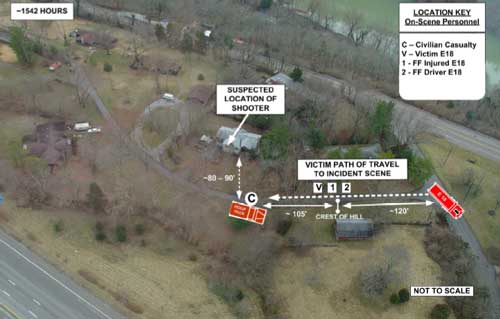 |
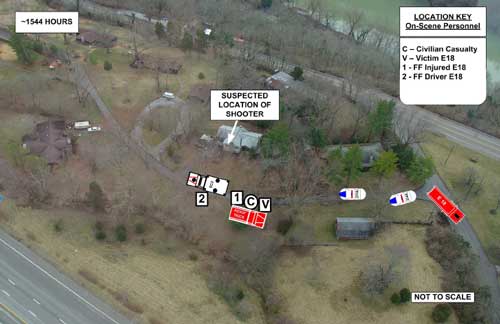 |
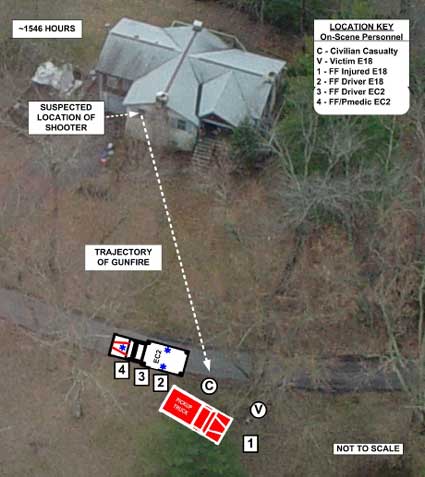 |
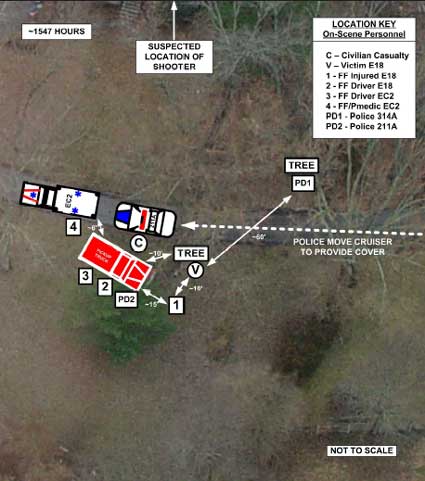 |
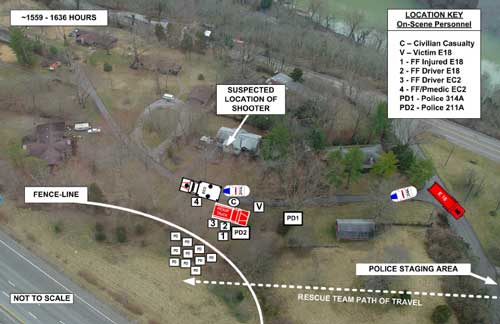 |
Photo 5. Incident scene depicting overview
of victim rescue. Background photo courtesy of the county division of police. |
Powerpoint version of Report 2004-11
Return to Fire Fighter Homepage
This page was last updated on 09/14/05.